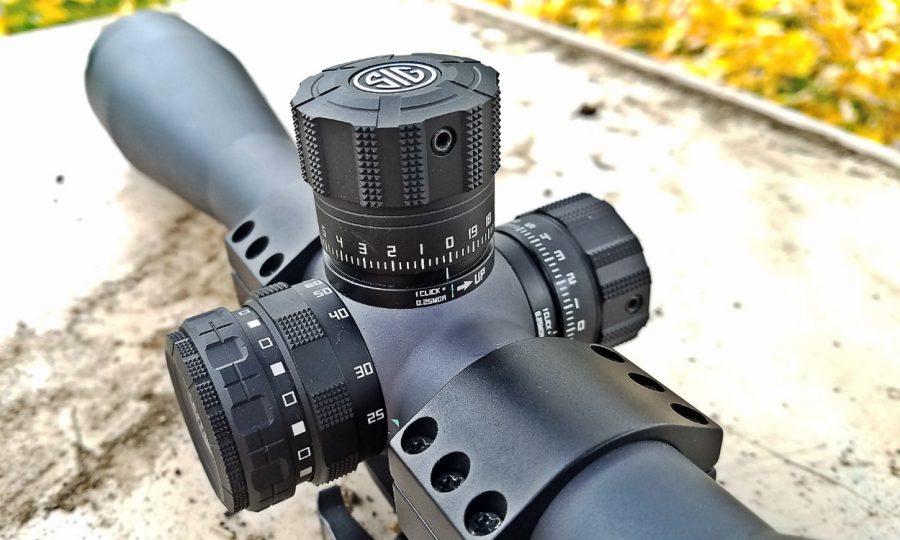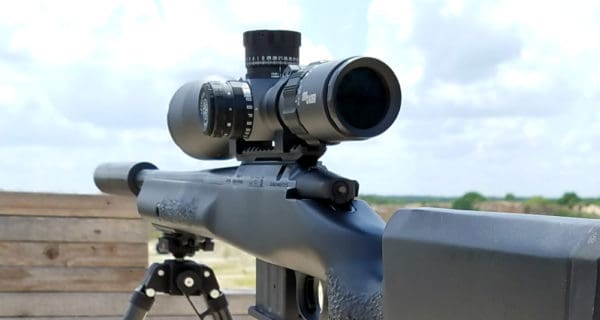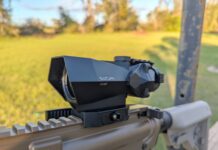Many shooters will never nail a sub-MOA group due not to a lack of skill or a questionable rifle, but to misunderstanding a scope‘s parallax adjustment and what it’s for. Hint: it ain’t “side focus.” Not really.
For scopes with adjustable parallax — which is going to be the majority of them with magnification over, oh, 8X or so — the first thing to know is to ignore the yardage markings on the parallax adjustment dial. On the vast majority of optics, even the high-end models, it simply isn’t accurate. Instead, you’ll want to determine the correct adjustments yourself via the method we’ll get to below.
Shout out: the parallax adjust on my SIG TANGO6 5-30x is one of the few that I’ve found to be dead-nuts accurate. As its little brother, the previously-reviewed TANGO6 3-18x (which I traded towards the 5-30x) was also perfect, I don’t think I simply got a ringer.
First, a step back . . .
What does parallax adjustment actually achieve? What is it for?
The — and I mean THE — purpose of a riflescope’s parallax adjustment is to put the reticle on the same focal plane as the target. The result of doing this correctly is that, should your eye move around in relation to the scope, the reticle doesn’t move around on the target.
While I understood the result and why it’s important, I didn’t truly understand the “same focal plane” thing (I didn’t even bother to understand the “how it works,” honestly) until Ladd Hall provided a wonderfully clear visual demonstration for me at Mill Creek Shooting Resort . . .
Look across the room you’re in and pick a small target. Yes, right now. Could be 10 feet away could be 50; doesn’t matter. Now stick your thumb up like you’re hitchhiking, close your non-dominant eye, and put that thumb right on target. Keeping your thumb dead still, move your head around a little. Your “reticle” (thumb) walks all freakin’ over the target.
Now, either get a helper or just imagine that somebody goes and physically places their thumb on your target. Move your head around as much as you’d like, and your “reticle” stays dead-on still, right on the bullseye.
The difference is focal plane. In the first scenario, your thumb is on a focal plane a few feet in front of your eye, while the target is on another plane farther afield. In the second scenario, the thumb is on the same focal plane as the target. Changing the angle between your eye and the target doesn’t move the reticle on the target, because they’re in the same place and the angle to both of them is always the same.
If you have an absolutely perfect cheek weld and place your eye in exactly the same location behind the scope on every single shot from every single firing position, you don’t need to worry about getting your parallax adjustment correct. Then again, you don’t actually exist. For the rest of us…all of us…
Adjusting For Parallax
Look through the scope and place the crosshair on a nice, small bullseye. With the rifle remaining as still as physically possible — ideally it’s on a rest or bipod setup of some sort — move your eye around without leaving the exit pupil (the image doesn’t disappear). Does the crosshair stay on the bull, or does it wander around? If it wanders, you need to adjust the parallax dial until it doesn’t.
This might be on the matching yardage mark on your scope’s parallax adjustment, but it probably won’t be. This might put the image in perfect focus, but it very well may not. Maybe the most common mistake shooters make is simply dialing to the mark on the parallax dial. Second most common: using it as a “side focus” and dialing until the image is as clear as possible.
The bottom line is that it doesn’t matter if the image is perfectly clear. It just has to be clear enough to identify the center of your bullseye. Zero parallax error comes first. If zero parallax and a clear-enough image don’t overlap, you have a faulty scope. Additionally, it absolutely doesn’t matter if your target is at 100 yards and you ended up parallax-free on your scope’s dial at the 70-yard or 135-yard mark. As long as there’s a way to dial out parallax at the distances you shoot at, you’re good.
Indeed, parallax needs to be adjusted every time the distance to your target changes. Leaving it adjusted for 100 yards and then engaging at 500 yards may result in a couple minutes of parallax error in the reticle. Forgetting to turn that parallax dial is a big mistake.
In The Field
While adjusting your scope’s parallax setting for every distance sounds slow and cumbersome, it’s something you should only have to do once at various distances. Basically, keep notes on paper or in your head. Once you know that a specific scope’s parallax adjustment dial should be at the 75-yard mark for a 100-yard target, 200-yard mark for a 200-yard target, 460-yard mark for a 400-yard target, infinity mark for anything beyond 500 yards, etc. etc., you shouldn’t have to do the head-wiggling test again.
But if you want to get the most accuracy out of your rifle, don’t avoid the head wiggle. Don’t avoid the effort needed to tinker with that dial until your parallax error is truly gone.
Dialing in “side focus” could leave you with a reticle that walks an inch off the bull due to moving your eye just a few millimeters in any direction behind the scope. Shot-to-shot, you could be doing everything absolutely perfectly behind a quarter-MOA-capable gun and never beat a one-minute group.
Parallax Error
Now that we know what parallax error is and what causes it, we know how important it is to adjust for it. Take the time, look a little silly wiggling your head around behind the scope, and correctly dial out your parallax error. Your groups will thank you for it.







“Shout out: the parallax adjust on my SIG TANGO6 5-30x is one of the few that I’ve found to be dead-nuts accurate. As its little brother, the previously-reviewed TANGO6 3-18x (which I traded towards the 5-30x) was also perfect, I don’t think I simply got a ringer.”
No, you didn’t get a ringer. My TANGO6 is the same, accurate parallax adjust.
Explained more than good enough for one just getting back into rife optics thank you.
Good enough explanation for my old eyes. I doubt I’ll go over 300 yards with my 1-6×24 LPVO. Good info nevertheless…
300 yards is *long* range for me too, but I still like reading about the theory
Haven’t shot past 300 yards since I was in the service ……….only just getting back into shooting at 100 yards now. Should be fun figuring out how much I forgot over a decade +
Focal planes? Parallax?
This all sounds like some round-earther conspiracy talk.
What’s in front of me is in front of me. Angles are satanic trickery.
@faking it dacian
Focal planes are those airplanes you see in the sky sometimes and you need to focus your eyes to make them out.
Parallax is the name of a new energy drink.
Angles are weirdly shaped angels, not satanic trickery.
round-earther conspiracy? Peshaw! Its not a conspiracy, its a collective of works by Ron Earther the acclaimed novelist on flat-earth #4.
Whats in front of you is not in front of you if its size is inconsistent with the surroundings.
https://www.youtube.com/watch?v=gK8H0dSUUks&pp=ygUWZW5kIG9mIGRheXMgdmlubmllIHBheg%3D%3D if you are going to go conspiracy theory at least try
As I have told my children time and time again. Trigonometry isn’t hard – if you understand how circles and triangles work.
Keep at it Dacian – you’ll figure it out eventually.
Question: Aside from the UTG Bug Buster Scope what else has parallax that is adjustable below 25 yards? I ended up getting one for close range nuisance animal work but am open to upgrading.
TTAG needs to run this article once a month.
LOL. We should do a bunch of articles like this! With so many new shooters and first-time gun owners, etc., we should try to do a whole lot more “XYZ for beginners” kind of things.
Any ideas? Topics, y’all, topics!…
Scope mounting/leveling would be a good intro to new rifle users, simple but there are a few things that can be messed up that one can forget about.
“Scope mounting/leveling would be a good intro to new rifle users…”
Or just “cheat”.
Use SPUHR mounts.These come with a 10deg leveling wedge. Perfection EVERY time. 😄
I can see why……….will have to put that purchase off for a bit and go with the scope rings I have for the moment though.
Scope leveling! Good one. I’ll get on it and I do have a good and fun tip for that one.
How about an article on the benefits of having BUIS on ARs.
Or…….gasp…….actually using them once or twice a year.
Baby steps James baby steps some of us needed to get a range first 🙂
Natural point of aim was taught to me through the AppleSeedProject. *(personal note: I’ve read TTAG article on AppleSeed that you may want to revisit or review from pov of a new long-gun shooter. I liked the program, taking it for the first time @54yo.
I think that the concept would also benefit newer shooters
And follow it up with one on how to do ranging with FFP scopes.
They’ve gotten cheap and people are buying them up because they cost more…
Nice article. All of a sudden my groups jumped all over the place. I’m going to pay extra attention to the parallax next time.
Comments are closed.